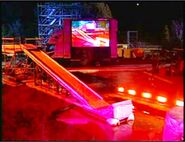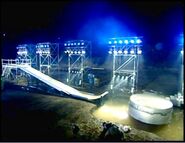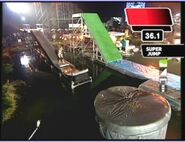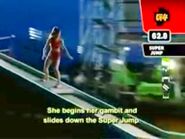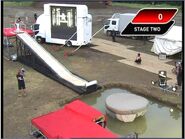(Removed photo that is deleted) Tag: rte-wysiwyg |
No edit summary |
||
| (3 intermediate revisions by 2 users not shown) | |||
| Line 28: | Line 28: | ||
}} |
}} |
||
| − | The '''Daichoyaku''' (大跳躍) has been the first obstacle in KUNOICHI's second stage for the first eight tournaments. Along with the [[Enchū Nori]], it is the only obstacle to appear in the first eight tournaments. The obstacle |
+ | The '''Daichoyaku''' (大跳躍) has been the first obstacle in KUNOICHI's second stage for the first eight tournaments. Along with the [[Enchū Nori]], it is the only obstacle to appear in the first eight tournaments. The obstacle consisted of a board stationed on a slope that ends with a ramp that competitors must slide on. Before the board hits the end of the ramp, competitors must jump from the board across a gap and reach a circular island cushion situated in the water. |
| + | A similar version of this obstacle (called as the [[Downhill Jump]]) would appear as the first obstacle in the Second Stage from [[SASUKE 18]] to [[SASUKE 24]], except the track was shorter and the presence of the rope at the end of the track. |
||
| ⚫ | |||
| + | |||
| ⚫ | |||
The first version of the Daichoyaku was the most difficult. The lead-up to the upper part of the ramp was extremely short, making it nearly impossible for competitors to time their jump and gather the momentum needed to reach the other side. Both competitors who attempted this version, Yamada Miho and Yusa Masami, failed, making this iteration the only version of the Daichoyaku to never be cleared. |
The first version of the Daichoyaku was the most difficult. The lead-up to the upper part of the ramp was extremely short, making it nearly impossible for competitors to time their jump and gather the momentum needed to reach the other side. Both competitors who attempted this version, Yamada Miho and Yusa Masami, failed, making this iteration the only version of the Daichoyaku to never be cleared. |
||
| − | == Version 2 ( |
+ | == Version 2 (KUNOICHI 2-7) == |
After the results of the first tournament, the Daichoyaku was toned down. The lead-up to the upper part of the ramp was lengthened so that competitors could actually build the momentum they would need to clear the obstacle. This version was the exact opposite of the first, only eliminating two competitors during its time on the course. The size of the landing cushion varied slightly, being larger in some tournaments, and slightly smaller in others. |
After the results of the first tournament, the Daichoyaku was toned down. The lead-up to the upper part of the ramp was lengthened so that competitors could actually build the momentum they would need to clear the obstacle. This version was the exact opposite of the first, only eliminating two competitors during its time on the course. The size of the landing cushion varied slightly, being larger in some tournaments, and slightly smaller in others. |
||
| − | == Version 3 ( |
+ | == Version 3 (KUNOICHI 8) == |
| − | The final version of the Daichoyaku was introduced in [[KUNOICHI 8]]. The board was made slightly smaller, and the wheels underneath the obstacle were made slightly larger. This made the board more unstable and resulted in several failures. For the course reboot in [[KUNOICHI 9]], the Daichoyaku was removed in favor of the Slide Walk. |
+ | The final version of the Daichoyaku was introduced in [[KUNOICHI 8]]. The board was made slightly smaller, and the wheels underneath the obstacle were made slightly larger. This made the board more unstable and resulted in several failures. For the course reboot in [[KUNOICHI 9]], the Daichoyaku was removed in favor of the [[Slide Walk]]. |
==Competitors' Success Rate== |
==Competitors' Success Rate== |
||
| + | *All results based on the TBS broadcast and external information found |
||
| − | |||
{|class="wikitable sortable" width="100%" |
{|class="wikitable sortable" width="100%" |
||
!width="20%" style="background-color: #4D0503;"|''KUNIOCHI'' |
!width="20%" style="background-color: #4D0503;"|''KUNIOCHI'' |
||
| Line 92: | Line 94: | ||
|align="center" style="background-color: #721410;"|85.54% |
|align="center" style="background-color: #721410;"|85.54% |
||
|} |
|} |
||
| + | |||
==Gallery== |
==Gallery== |
||
<gallery> |
<gallery> |
||
| Line 102: | Line 105: | ||
DaichoyakuKunoichi8.jpg |
DaichoyakuKunoichi8.jpg |
||
</gallery> |
</gallery> |
||
| + | [[Category:KUNOICHI obstacles]] |
||
Revision as of 15:32, 18 November 2017
The Daichoyaku (大跳躍) has been the first obstacle in KUNOICHI's second stage for the first eight tournaments. Along with the Enchū Nori, it is the only obstacle to appear in the first eight tournaments. The obstacle consisted of a board stationed on a slope that ends with a ramp that competitors must slide on. Before the board hits the end of the ramp, competitors must jump from the board across a gap and reach a circular island cushion situated in the water.
A similar version of this obstacle (called as the Downhill Jump) would appear as the first obstacle in the Second Stage from SASUKE 18 to SASUKE 24, except the track was shorter and the presence of the rope at the end of the track.
Version 1 (KUNOICHI 1)
The first version of the Daichoyaku was the most difficult. The lead-up to the upper part of the ramp was extremely short, making it nearly impossible for competitors to time their jump and gather the momentum needed to reach the other side. Both competitors who attempted this version, Yamada Miho and Yusa Masami, failed, making this iteration the only version of the Daichoyaku to never be cleared.
Version 2 (KUNOICHI 2-7)
After the results of the first tournament, the Daichoyaku was toned down. The lead-up to the upper part of the ramp was lengthened so that competitors could actually build the momentum they would need to clear the obstacle. This version was the exact opposite of the first, only eliminating two competitors during its time on the course. The size of the landing cushion varied slightly, being larger in some tournaments, and slightly smaller in others.
Version 3 (KUNOICHI 8)
The final version of the Daichoyaku was introduced in KUNOICHI 8. The board was made slightly smaller, and the wheels underneath the obstacle were made slightly larger. This made the board more unstable and resulted in several failures. For the course reboot in KUNOICHI 9, the Daichoyaku was removed in favor of the Slide Walk.
Competitors' Success Rate
- All results based on the TBS broadcast and external information found
| KUNIOCHI | Clears | Attempts | Percentage |
|---|---|---|---|
| 1 | 0 | 2 | 0% |
| 2 | 2 | 3 | 66.66% |
| 3 | 14 | 14 | 100% |
| 4 | 8 | 8 | 100% |
| 5 | 6 | 6 | 100% |
| 6 | 10 | 11 | 90.9% |
| 7 | 4 | 4 | 100% |
| 8 | 27 | 35 | 77.14% |
| Total | 71 | 83 | 85.54% |

